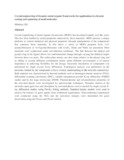Please use this identifier to cite or link to this item:
https://cris.library.msu.ac.zw//handle/11408/2840| Title: | Crystal engineering of dynamic metal-organic frameworks for applications in chromic sensing and capturing of small molecules | Authors: | Mehlana, Gift | Keywords: | Chemistry Metal-organic frameworks |
Issue Date: | 2014 | Publisher: | University of Cape Town | Abstract: | Crystal engineering of metal organic frameworks (MOFs) has developed rapidly over the years. This has been fuelled by useful properties endowed by these materials. MOFs present a unique platform to control chemical and physical properties through manipulation of the components that construct these materials. In this thesis a series of MOFs prepared from 3-(4-pyridyl)benzoate or 4-(4-pyridyl)benzoate with Co(ll), Zn(ll) and Ni(ll) are presented. Most materials were synthesised under solvothermal conditions. The link between the phenyl and pyridyl ring in the ligand allows for conformational change through varying the dihedral angles between these two parts. The carboxylate moiety can also rotate relative to the phenyl ring and its ability to assume different coordination modes under different environments is of utmost importance in achieving flexibility for the design. Structural elucidation of compounds was performed by single crystal X-ray diffraction. Topological analysis was performed on the networks formed by the compounds to have a better understanding of the network connectivity. Bulk material was characterised by thermal methods such as thermogravimetric analysis (TGA), differential scanning calorimetry (DSC), variable temperature powder X-ray diffraction (PXRD) studies and by hot stage microscopy (HSM). Thermochromic and solvatochromic properties of the activated phases were investigated by spectroscopic techniques. Dynamic motion of the networks upon guest loss and absorption by activated phases were evaluated by single crystal X-ray diffraction studies using Pawley fitting methods. Standard kinetic models were used to analyse the kinetics of guest uptake from isothermal experiments. Non-isothermal experiments were conducted using the TGA and the activation energies were determined for guest desolvation using the Ozawa and Flynn method. | URI: | https://open.uct.ac.za/handle/11427/13360 http://hdl.handle.net/11408/2840 |
| Appears in Collections: | Theses |
Files in This Item:
| File | Description | Size | Format | |
|---|---|---|---|---|
| Crystal engineering of dynamic metal organic frameworks for applications in chromic sensing and capturing of small molecules.pdf | Abtract | 9.92 kB | Adobe PDF |  View/Open |
Page view(s)
220
checked on Jan 10, 2026
Download(s)
52
checked on Jan 10, 2026
Google ScholarTM
Check
Items in MSUIR are protected by copyright, with all rights reserved, unless otherwise indicated.



